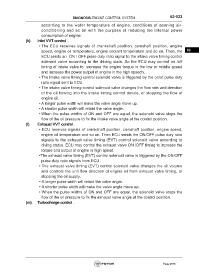Page 2575 - Foton Workshop Manual - Sauvana
P. 2575
DIAGNOSIS-ENGINE CONTROL SYSTEM 62-523
according to the water temperature of engine, conditions of opening air-
conditioning and so on with the purpose of reducing the internal power
consumption of engine.
(k). Inlet VVT control .
• The ECU receives signals of crankshaft position, camshaft position, engine
speed, engine oil temperature, engine coolant temperature and so on. Then, the 62
ECU sends an ON / OFF pulse duty ratio signal to the intake valve timing control
solenoid valve according to the driving state. So the ECU may control on /off
timing of intake valve to increase the engine torque in the low or middle speed
and increase the power output of engine in the high speech. .
• The intake valve timing control solenoid valve is triggered by the on/of pulse duty
ratio signal sent to ECU.
• The intake valve timing control solenoid valve changes the flow rate and direction
of the oil flowing into the intake timing control device, or stopping the flow of
engine oil.
• A longer pulse width will make the valve angle move up.
• A shorter pulse width will retard the valve angle.
• When the pulse widths of ON and OFF are equal, the solenoid valve stops the
flow of the oil pressure to fix the intake valve angle at the control position.
(l). Exhaust VVT control .
•·ECU receives signals of crankshaft position, camshaft position, engine speed,
engine oil temperature and so on. Then ECU sends the ON/OFF pulse duty ratio
signals to the exhaust valve timing (EVT) control solenoid valve according to
diving status. ECU may control the exhaust valve ON /OFF timing to increase the
torque and output of engine in high speed.
•The exhaust valve timing (EVT) control solenoid valve is triggered by the ON/OFF
pulse duty ratio signals from ECU .
•·The exhaust valve timing (EVT) control solenoid valve changes the oil volume
and controls the unit flow direction of engine oil from exhaust valve timing, or
stopping the oil supply.
•·A longer pulse width will retard the valve angle.
•·A shorter pulse width will make the valve angle move up.
•·When the pulse widths of ON and OFF are equal, the solenoid valve stops the
flow of the oil pressure to fix the exhaust valve angle at the control position.
(m). Turbocharge control .
Page 2575

